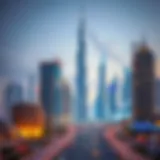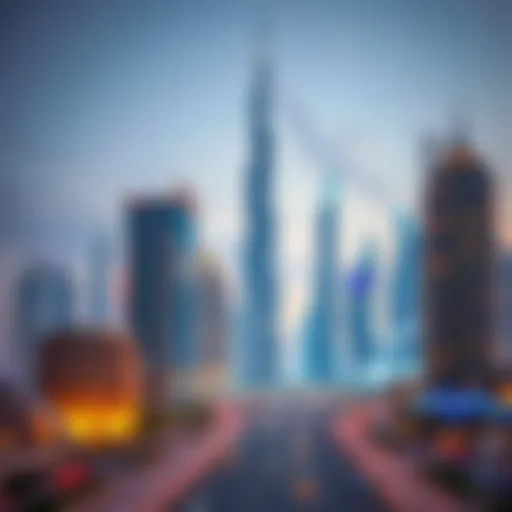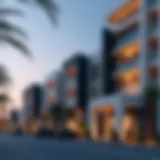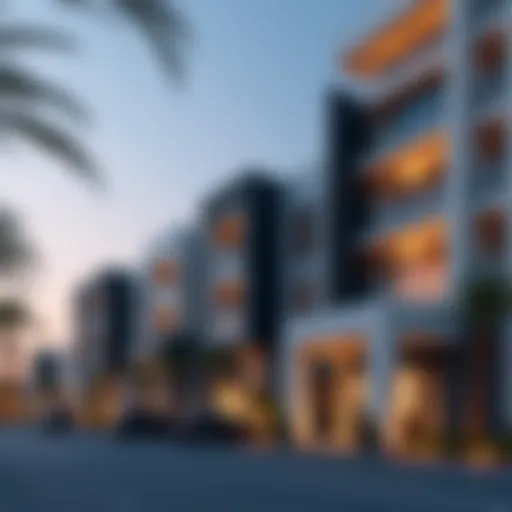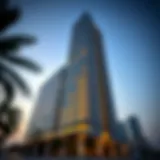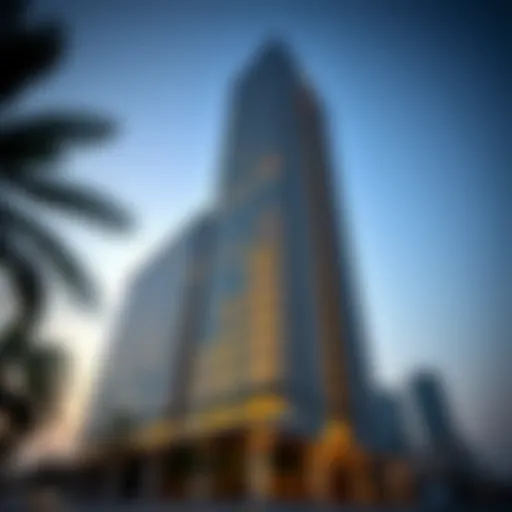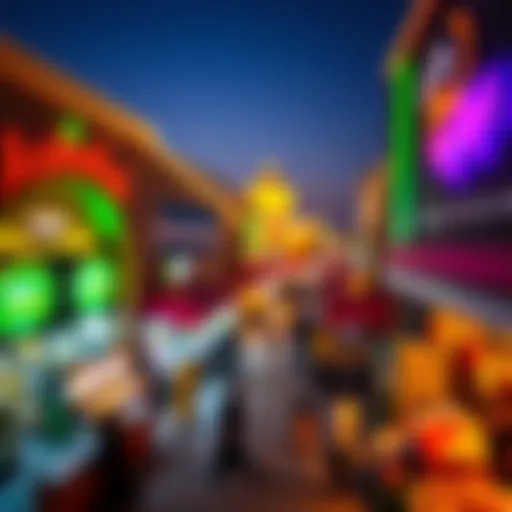Explore Dubai's Iconic Towers: Architecture and Investment
Intro
Dubai, a city that seems to rise from the desert, has transformed itself into a global beacon of innovation and architectural prowess. Its skyline, adorned with towering marvels, speaks volumes about the city’s rapid development and ambitious vision. These iconic towers are not just structures of glass and steel; they are symbols of Dubai’s relentless pursuit of modernity and luxury. As investors and homeowners turn their gaze towards this vibrant market, understanding the architectural significance and the investment opportunities associated with these buildings becomes crucial.
The narrative begins by unpacking the historical context of Dubai's evolution. Once a modest fishing village, the city has undergone a metamorphosis unlike any other, driven by strategic vision and ingenuity. This backdrop sets the stage for the exploration of the outstanding design intricacies that characterize Dubai's architectural landscape. Notable architects, pioneers in their fields, have left indelible marks on the city, creating structures that defy gravity and redefine urban living.
Moreover, as we delve deeper, we will address the often overlooked economic aspects. The interplay between architecture and real estate investment invites a closer look at the current market trends, future forecasts, and the types of properties that dominate this evolving landscape. Investors, agents, and homeowners alike will find insightful perspectives on navigating the vast opportunities that Dubai’s towers present.
In this exploration, we invite you to join us in understanding not only the aesthetic allure of these skyscrapers but also their compelling investment potential. Welcome to a journey through the heights of innovation and investment in Dubai.
Intro to Iconic Towers
The towers of Dubai stand tall not just as mere structures of steel and glass, but as remarkable testaments to the city’s ambition and creative spirit. Each building showcases an intricate blend of art and engineering, reshaping the horizon in ways that continually spark fascination.
Understanding the significance of these towers extends beyond aesthetics. They serve as vital components of Dubai’s real estate landscape, providing investment opportunities that many keen investors and homebuyers gravitate towards. The allure isn’t just about the beauty of the buildings; it’s also about the potential profits and lifestyle they promise. Investors picking the right time and tower can see significant returns, whether they are seeking rental income or capital appreciation.
Moreover, the iconic towers act as a barometer for the city’s economic health. A flourishing skyline often mirrors a thriving economy, which means that investors staying abreast of these developments can gain insights into market dynamics.
The towers invite investors, homebuyers, and professionals alike to explore not just property ownership but an entire lifestyle—where luxury meets practicality and innovation intersects with tradition. Delving into the unique architectural characteristics of these towers, and their historical backgrounds, can provide invaluable context for understanding their importance in today’s investment climate.
In essence, this exploration is more than just recognizing remarkable buildings; it’s about uncovering the narratives that propel these structures into the forefront of both architectural ingenuity and economic vitality.
"Iconic towers are symbols of aspiration, each one might just hold the key to unlocking favorable investment opportunities in one of the fastest growing markets in the world."
This introduction sets the stage for a deep dive into the intricacies of Dubai's iconic towers, highlighting their architectural significance and the lucrative prospects they present to investors, homebuyers, and industry analysts.
Historical Context of Dubai's Skyline
Understanding the historical context of Dubai’s skyline is not just an exercise in architecture; it offers insights into the socio-economic transformation of a land once primarily defined by its desert vistas. The evolution of its iconic towers symbolizes the relentless ambition and progressive vision of the Emirati leadership. They reflect the blend of tradition and modernity that characterizes Dubai today. Looking back provides valuable context for current and future investments within this remarkable urban landscape.
Origins of Modern Architecture in Dubai
The origins of modern architecture in Dubai can be traced back to pragmatic needs and ambitious aspirations. In the early 20th century, Dubai was a modest fishing and pearl diving village. The architecture was simple, with structures mostly built from coral, limestone, and palm fronds. Fast forward to the late 1970s and 1980s, and you see the seeds of change being sown. The discovery of oil in the 1960s sparked immense wealth and, in turn, an urge for a new identity.
During this time, visionary leaders recognized the importance of architecture in branding Dubai as a global destination. The Emirate began inviting talented architects from around the world, ensuring a fusion of styles and techniques. For instance, the Dubai Trade Centre, completed in 1979, was the first skyscraper that set the tone for what was to come. It was a clear statement of intent, establishing Dubai on the global architectural map. Later pieces like the Burj Al Arab epitomized luxury and uniqueness, becoming a defining symbol of the city.
With these changes, architecture became an expression of not just wealth but also of cultural aspirations, a way to forge a forward-thinking identity that embraces innovation while respecting tradition. This duality is crucial in understanding the skyline’s development and must be a key consideration for any investor aiming to grasp the full picture.
The Transformation of Urban Spaces
The transformation of urban spaces in Dubai has been nothing short of astounding. Once primarily a fishing port, the city has undergone radical metamorphoses into a gleaming metropolis replete with skyscrapers that touch the clouds. This rapid transition raised several significant questions about sustainability, livability, and urban planning.
The Dubai Marina, initially an ambitious reclamation project, has now turned into one of the city’s most vibrant neighborhoods, showcasing how water and urban living can harmonize. In contrast, areas like Downtown Dubai and Business Bay have been meticulously planned to blend commercial with residential life, showing a mature understanding of urban dynamics.
Furthermore, each iconic tower not only offers shelter but also facilitates economic activities—hosting everything from multinational corporations to luxury apartments. This economic magnetism invites investors by providing not just homes or offices but an entire lifestyle experience.
"In Dubai, every skylight shines a light on the future, telling tales of dreams realized and ambitions reignited."
For a more in-depth look into the architectural progression of Dubai, check out resources like Wikipedia on Dubai and insightful analyses from Britannica.
Defining Architectural Innovation
In the context of Dubai's rising skyline, architectural innovation holds a significant place as both an aesthetic and functional element. This subject is not just about the use of new technologies or materials; it embodies the essence of rethinking how we design and inhabit urban spaces. The towers of Dubai stand as testaments to human creativity—each structure telling its unique story while also serving to improve the quality of life for those who interact with them.
The importance of understanding architectural innovation lies in its direct connection to investment potential. Investors need to appreciate which design features attract tenants or buyers, as well as how sustainability practices can lead to long-term economic benefits. With the global shift towards more responsible building practices, stakeholders can leverage this knowledge for informed investment decisions.
Unique Design Features of Iconic Towers
Diving into the unique design features, one can see that they vary immensely from one tower to another, yet they often share common traits that define Dubai's architectural language. Take Burj Khalifa for example; its sleek, tapering silhouette serves not only as an eye-catching focal point but also efficiently reduces wind load—a critical factor in skyscraper engineering. Meanwhile, The Burj Al Arab, with its distinctive sail-shaped structure, reflects luxury and innovation, both in its aesthetic and its high-tech amenities. These towers are not merely functional; they are designed to provoke thought and admiration.
Among the features that stand out across various structures are:
- Adaptive Reuse of Space: Many towers incorporate areas that serve multiple purposes, such as residential, commercial, and recreational.
- Cultural Significance: Elements that represent the local culture are often embedded within designs, giving context and meaning to the structures. For example, the intricate patterns on the facades resonate with traditional Arabic art.
- Cutting-Edge Technology: Modern towers are integrating smart technology to enhance efficiency. Automated systems for climate control and energy consumption monitoring can be found in various buildings.
These innovative design principles not only enhance visual appeal but also align with the expectations of a modern, globalized society.
Sustainability in Tower Design
The conversation around sustainability in architectural design cannot be overlooked. As investments in iconic towers continue to rise, so does the responsibility to design them with an eye towards eco-conscious practices. Sustainable architecture is not just a trend; it’s rapidly becoming a necessity as environmental awareness grows globally.
Sustainability in tower design includes a multitude of approaches:
- Use of Renewable Materials: Many architects now opt for materials that offer less environmental impact and greater energy efficiency. This includes recycled steel, sustainable timber, and other materials that can withstand the arid climate of Dubai.
- Green Roofs and Vertical Gardens: These features can drastically reduce the heat absorbed by buildings, offering a more pleasant environment for inhabitants and reducing energy costs associated with air conditioning.
- Water Conservation Systems: Advanced plumbing and water recycling systems are also being integrated into newer tower designs, significantly reducing water waste.
Research suggests that implementing sustainable practices not only meets regulatory standards but can also lead to enhanced property values and tenant satisfaction.
Prominent Towers in Dubai
Dubai's skyline is dominated by towers that not only represent architectural prowess but also significant investment opportunities. As symbols of modernization, these structures do more than just reach for the clouds; they embody the ambitions of a city that transformed from a fishing village to a global hub. Each tower has its own narrative, a unique design that resonates with both locals and tourists alike. Understanding their importance is essential for anyone looking to navigate through Dubai's bustling real estate market. Investors see potential in these towers, as they often go hand in hand with rising property values, tourism, and new business ventures.
Burj Khalifa: The Pinnacle of Skyscrapers
Holding the title as the tallest building in the world, Burj Khalifa isn't just a record-holder; it’s a symbol of what Dubai stands for. At a staggering height of 828 meters, this skyscraper offers unparalleled views and a unique experience as visitors can ascend to the observation deck on the 148th floor. The design, inspired by the desert flower Hymenocallis, serves as an architectural marvel.
Significance for Investors:
- Luxury Living: The amenities and luxury apartments attract high-net-worth individuals.
- Tourism Magnet: Millions flock to the Burj Khalifa yearly, boosting local businesses.
- Brand Association: Owning property in or around the Burj Khalifa often comes with prestige.
The Burj Al Arab: A Symbol of Luxury
With its distinctive sail-like silhouette, Burj Al Arab epitomizes luxury and opulence. This hotel is more than just a place to stay; it's a statement of exclusivity. Boasting a seven-star status and lavish amenities, it caters to elite clientele looking for an extraordinary experience.
Key Considerations:
- Investment in Hospitality: The Burj attracts high-profile tourists willing to pay top dollar for unique experiences.
- Development Potential: Properties nearby often see their values increase due to the allure of the Burj Al Arab.
Princess Tower: Residential Achievement
Princess Tower distinguishes itself as one of the tallest residential buildings globally. Rising 413 meters high, it comprises 764 apartments, offering stunning panoramic views of the Palm Jumeirah and the Arabian Sea. Residents indulge in world-class amenities, like a swimming pool, health club, and children's play area.
Residential Investment Benefits:
- Affordability: Compared to other luxury towers, apartments here offer more value for families.
- Community Vibe: It's a family-friendly environment, appealing to both expats and locals.
Marina 101: A Testament to Modern Engineering
Marina 101 is an intriguing addition to Dubai’s architectural landscape, reaching 425 meters. It showcases not only aesthetic design but also engineering prowess. The development features both residential and commercial spaces, striking a balance of urban living and working environments.
Investment Insights:
- Mixed-Use Opportunities: The blend of residential and commercial areas makes it attractive for businesses and residents alike.
- Strategic Location: Situated in Dubai Marina, it benefits from the area's high demand.
"Dubai's towers are not just buildings; they're investment goldmines, representing both heritage and economic growth."
Architectural Influences
The architectural landscape of Dubai is not just defined by the buildings themselves, but also by the diverse influences that shape their design and conception. This section dives into why architectural influences matter in the context of this article, particularly focusing on the creative confluence of various styles, sustainable practices, and cultural elements that contribute to the city’s unique identity.
Understanding these influences can illuminate how Dubai has become a bustling hub for innovation, culture, and economic activity, and serves as a guide for investors looking to navigate this dynamic environment.
Not only do the iconic towers exemplify technological advancement, but they also stand as testimony to the collaboration between local artisans and international designers. By analyzing these myriad influences, one can gain insight into potential future trends in the market, enhancing decision-making for investors and stakeholders. One important aspect is how architecture in Dubai often responds to the challenges of the environment, climate, and cultural context, ensuring that these giant structures are not only visually stunning but also functional.
Notable Architects Shaping Dubai
As one meanders through Dubai’s skyline, it becomes clear that behind each towering structure is a visionary architect who has left an indelible mark on the city. For instance, architects like Adrian Smith, who was pivotal in designing the Burj Khalifa, have significantly influenced the global perception of modern skyscrapers.
- Zaha Hadid brought fluidity to Dubai's architecture, leaving behind a legacy with her distinct curves evident in projects like the Dubai Opera.
- Foster + Partners contributed with their eco-friendly designs, emphasizing sustainability without compromising on luxury, like in the case of the Masdar City.
- Kengo Kuma, who focuses on blending structures with natural elements, has also made a mark in Dubai by designing buildings that connect people with nature, like the Dubai Creek Tower.
These architects do not just design buildings; they create experiences, integrating functionality with aesthetic appeal. Investors who are aware of the work done by these prominent names can better appreciate their projects’ market value and design integrity.
Cultural Elements in Design
Delving deeper, the cultural elements woven into the fabric of Dubai’s towers underscore the region’s rich history and diverse population. These towers often incorporate Islamic architectural motifs, blending them with modern techniques to create a distinctive style that is uniquely Dubai.
For instance, the use of geometric patterns is prevalent in many towers, reflecting traditional designs while appealing to contemporary tastes. Other aspects include:
- Materials: The use of local stone and glass not only accentuates a building’s beauty but also ties it back to the natural landscape of the UAE.
- Layouts: Many structures pay homage to traditional Arab cultural norms, such as privacy considerations in residential designs, ensuring they resonate well with local sensibilities.
- Landscaping: The integration of gardens and water features within the architecture enhances the overall aesthetic and provides respite from the desert heat, reflecting a thoughtful approach to urban planning.
Understanding these cultural elements is crucial for potential investors. It can give them a sense of the longevity and appeal of a given property, ensuring that they invest not just in a structure, but also in a narrative deeply rooted in the cultural identity of Dubai.
Economic Impact of Iconic Towers
The economic relevance of Dubai's iconic towers extends far beyond their impressive facades or architectural brilliance. These buildings represent a formidable driving force behind Dubai's rapid economic transformation and serve as integral components in attracting investment and tourism. The skyline of Dubai, dominated by these monumental towers, mirrors the ambition and vision of the Emirate's leaders, illustrating their commitment to creating a world-class city that thrives on innovation and economic diversifiation.
One of the primary elements of this economic impact is the significant increase in real estate values associated with iconic towers. The performance of properties within close proximity to these towers often exceeds that of conventional developments. This phenomenon can lead to attractive returns for investors and fosters a vibrant real estate market. As each tower rises, so does the demand for commercial and residential spaces nearby, creating a ripple effect throughout the property market and spurring new developments.
Real Estate Value Trends
Real estate value trends in Dubai’s premium districts are tightly interwoven with the presence of iconic towers. For instance, properties in the vicinity of the Burj Khalifa often display upward momentum in pricing, as buyers are drawn to the allure of living or working in close proximity to such a landmark. The prestige associated with these buildings culminates in neighborhoods perceived as not only desirable but also lucrative investments.
Factors impacting value trends include:
- Proximity to Major Amenities: Towers like the Burj Al Arab offer residents unparalleled access to luxury hotels and high-end boutiques, driving up demand and consequently rental and sale prices.
- Economic Indicators: Market analysis often reveals that fluctuations in Dubai's economy directly impact real estate prices. During booming periods, investors seek these landmark properties, inflating their value.
- Brand Recognition: The iconic status of these towers enhances the overall perception of the market, drawing the attention of international investors.
Tourism Attraction and Economic Growth
The towering landmarks of Dubai serve as magnets for tourists, enhancing not only the local economy but also positioning Dubai as a global tourism hub. These skyscrapers are not merely residential or commercial spaces; they offer immersive experiences that enrich visitor engagement.
The contribution of iconic towers to tourism can be analyzed through:
- Cultural Significance: Drawing millions of visitors annually, structures like the Burj Khalifa are as much about symbolism as they are about architectural feats. Their presence on the skyline is often the primary driver for tourist visits, facilitating the growth of the hospitality sector.
- Economic Multiplier Effect: As tourists flock to see these marvels, they stimulate various sectors including retail, dining, and entertainment. This leads to increased job creation and economic activity, significantly benefiting the local population.
- Enhanced Global Presence: The architectural prowess displayed by Dubai’s iconic towers is frequently showcased in global media and marketing campaigns, further establishing Dubai as a prime destination.
"The financial benefits derived from these towers not only uplift the local economy but also generate a more favorable environment for future investments."
Overall, the economic impact of Dubai's iconic towers is akin to a domino effect — each block falling into place and creating opportunities for many. In the competitive climate of international real estate, these structures do not just define the city’s skyline; they also pave the way for financial prosperity and sustainable growth.
Future Developments in Dubai
The skyline of Dubai is a visual symphony, composed of architectural triumphs that not only signify the present aspirations of the city but also pave the path for its future. When discussing Future Developments in Dubai, this article emphasizes the pivotal role these forthcoming projects play in shaping both the urban landscape and the investment climate. As the city continues to grow, it becomes essential to highlight progressive architectural ambitions and sustainability initiatives that will further establish Dubai as a leading global hub for business and tourism.
Investors and developers can find immense value in understanding these developments, as they bring opportunities to diversify portfolios and tap into emerging real estate markets. Additionally, these initiatives reflect the cultural and economic evolution of Dubai, inspiring confidence among stakeholders about the city’s commitment to innovation and quality living environments.
Upcoming Architectural Projects
Dubai never seems to rest when it comes to development. Several striking architectural projects are on the horizon, which promise to add unique features to the already remarkable skyline. One of the key projects is the Dubai Creek Tower, aimed at surpassing the Burj Khalifa in height. Not only will it foster tourism, but it will also encapsulate the spirit of Dubai's ambition.
Other notable projects include the Dubai One Za'abeel, which is poised to be the world’s tallest building when completed, featuring cutting-edge facilities conducive for both business and recreation. There’s also the Mohammed bin Rashid City, which combines residential areas with retail space and leisure facilities, thereby merging life’s many facets in one sprawling estate.
- Dubai Creek Tower
- Dubai One Za'abeel
- Mohammed bin Rashid City
These upcoming structures are not simply about height or grandeur. They represent a shift towards creating more integrated environments where communities can thrive. This makes them not just physically impressive but valuable assets in an increasingly competitive property market.
Vision for Sustainable Urban Development
Sustainability is becoming a cornerstone of urban planning in Dubai. As the world grapples with climate change, Dubai is stepping up its ambitions to create a sustainable future, integrating eco-friendly practices into its architectural developments. This Vision for Sustainable Urban Development is crucial, as it addresses the pressing concerns of today's society while ensuring long-term viability for future generations.
The city’s commitment to sustainability is evidenced through initiatives like the Dubai Clean Energy Strategy 2050, which aims to make the emirate a global center of clean energy and green economy.
Incorporating green technologies and sustainable practices includes:
- Utilizing energy-efficient materials
- Creating green spaces within urban settings
- Adopting renewable energy sources
These efforts highlight the importance of synergy between modern architecture and environmental stewardship. Investors can benefit from a focus on sustainable developments, as properties aligned with ‘green practices’ are anticipated to see increased demand and higher property values. Moreover, future regulations may favor sustainably designed buildings, further reinforcing the viability of investments in these types of projects.
"The future does not belong to those who think it will be, but to those who actively shape it."
In summary, the Future Developments in Dubai reflect a blend of ambition and responsibility, creating avenues for investment and fostering a world-class environment. Understanding this landscape gives investors an upper hand in navigating the evolving real estate market.
Investing in Iconic Towers
Investing in iconic towers in Dubai goes beyond just purchasing a piece of property. It embodies a deeper understanding of an evolving market, one that intertwines modern architectural achievements with economic diversification. The availability of these towering structures, whether for residential living or commercial use, offers various benefits to potential investors. Important elements like location, design, and historical significance make these towers not just landmarks, but also lucrative investment opportunities.
One cannot emphasize enough the importance of location in real estate. Dubai, with its strategic geographical position and state-of-the-art infrastructure, attracts both local and international investors. The iconic towers are often situated in prime areas, providing direct access to markets, business districts, and leisure activities. Moreover, these buildings often appreciate in value over time, making them a wise financial choice.
Additionally, the architectural integrity and prestige associated with towers such as the Burj Khalifa and the Burj Al Arab serve as a magnet for affluent buyers. Investing in such towers not only provides a home or business location; it also elevates the investor’s status. This amalgamation of luxury and functionality ensures a steady interest from high-net-worth individuals, further inflating property values.
Investors also stand to gain from the growing tourism sector. Dubai's iconic landmarks attract millions of visitors annually, creating a demand for short-term rentals. Owning property within these towers can lead to significant profit margins from holiday-home rentals, all thanks to their allure and the tourism boom. In essence, the opportunities for maximizing returns are diverse and appealing.
However, like any investment, it’s crucial to navigate carefully through market dynamics and current trends to make informed decisions.
Understanding Market Dynamics
To grasp the market dynamics of investing in iconic towers, one must first consider the broader economic landscape of Dubai. The tapestry woven from various sectors—tourism, technology, and finance—affects real estate prices directly. Recently, there has been a noticeable shift in buyer demographics, with a growing number of expatriates and foreign investors yearning to sink roots in the vibrant city.
Furthermore, regional stability and government policies significantly influence investor sentiment. The government's initiatives, like the Dubai 2040 Urban Master Plan, aim to expand the city’s infrastructure, thereby enticing more investors.
Economic indicators like employment rates, per capita income, and population growth are vital metrics to watch as they often correlate with property demand. Understanding these dynamics equips investors with the knowledge to predict trends, minimizing risks.
Evaluating Investment Opportunities
Evaluating investment opportunities in Dubai's iconic towers involves a thorough analysis of each property’s characteristics and the broader market context. Prospective investors should consider several factors:
- Return on Investment (ROI): This metric gives insights into potential profitability. Towers that already have tenants can offer immediate returns, while others might require a bit of patience but promise higher yields in the long run.
- Market Trends: Keeping an ear to the ground for emerging trends can provide a competitive edge. For instance, an upward trend in foreign investments or increasing rental rates might signal a beneficial time to purchase.
- Building Specifications: Understanding the specifics—such as amenities, building materials, and reputation of the developer—can impact both rental potential and resale value. A building that emphasizes sustainability or luxurious features often commands premium prices.
- Investment Exit Strategies: It is crucial to consider how and when one wishes to cash in on an investment. Whether through selling, renting, or via other means, knowing exit strategies beforehand can greatly influence purchasing decisions.
Keeping these considerations in mind, investing in Dubai’s iconic towers emerges as not only a practical choice but also an emotionally invigorating journey—one tied to the city’s grandeur and future aspirations.
"The old adage that real estate is all about location may have some merit, but in Dubai, it’s also about prestige. "
End: The Lasting Impact of Dubai's Iconic Towers
The exploration of Dubai's iconic towers reveals much more than just stunning visuals or architectural achievements. These skyscrapers represent the ambition and relentless spirit of a city that has transformed its identity within a few decades. Each building stands tall not only as a feat of engineering but also as a beacon of opportunity, investment potential, and cultural significance.
Significance Beyond Just Architecture
At first glance, the towers might seem like a collective skyline vanity, but they are deeply interwoven with the city’s narrative of progress. For investors, these structures symbolize not just a place to live or work, but a thriving marketplace with endless possibilities. For homebuyers, they offer a unique lifestyle that combines luxury with cutting-edge conveniences.
The architectural genius displayed in structures like the Burj Khalifa and the Burj Al Arab sends a clear message — quality matters. These towers are crafted with precision, showcasing innovative design that integrates sustainability. The incorporation of green technologies represents an important consideration for the future of urban development, ensuring these buildings stand the test of time.
"The skyline of a city is a direct reflection of its dreams and aspirations. In Dubai, its towers are aspirations made manifest."
Economic Ripple Effects
The economic implications of these iconic towers extend beyond their immediate transaction values. They fuel tourism, attract global investors, and contribute significantly to the real estate market. As travelers flock to see these wonders, they not only boost the hospitality sector but also enhance local businesses around them. Consequently, the socio-economic fabric of Dubai gets richer, diversifying its revenue streams and decreasing reliance on oil.
A Future Full of Promise
While the current impact is considerable, the future also looks promising. With several innovative projects on the horizon, the potential for even more iconic buildings seems undaunted. Each new development aims to tackle challenges such as affordability, accessibility, and environmental impact, ensuring that Dubai continues to evolve as a model for urban expansion. Investors and developers must remain vigilant, paying close attention to emerging trends that dictate which properties will thrive in the long run.






